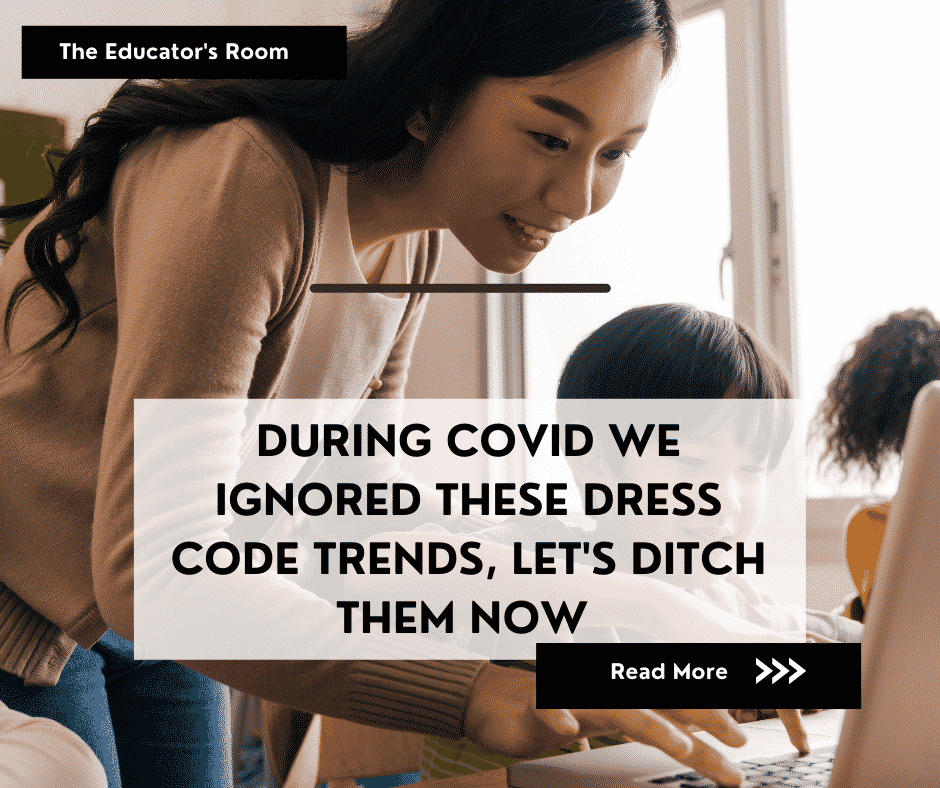When teachers and students got sent home in March 2020, one of the many school norms suddenly ignored was the dress code for students and teachers alike. My own children used to normally wearing, khakis and polo shirts, suddenly lounged in athletic shorts and t-shirts as they sat in front of computers, completed homework, and interacted with peers. As I met with students, I discovered young women unafraid to wear tank tops and color their hair and young men who decided to just let their hair grow, both on their head and face. Teenagers who spent a significant amount of school time complaining about restrictions embraced the unspoken permission to ignore the grooming standards that our school’s dress code normally required.
As I watched students return for final registration in the fall of 2020, many of my former students had continued to let their hair go wild, boys showing up with scruffy beards and hair below their collars and girls sporting every color of the rainbow on top of their heads. One parent emailed me to ask about hair length in senior photos because their son wasn’t quite ready to get the haircut required before school actually started. I complimented another young man on his sleek and well-maintained ebony mane, which had clearly passed his shoulders and would most likely get him a call down to the office within the first few days of school. I inwardly sighed as I recognized that his well-groomed appearance would not meet our school’s “neat and modest” dress code standard.
It wasn’t the first time that I questioned why it mattered, but as we returned to school amid a global pandemic that wasn’t ending any time soon, it seemed that the fight worth having was over whether or not kids were properly masked, not whether or not they were following arbitrary grooming standards.
Over the last two years, the conversation over dress codes and grooming has become increasingly tense in some school settings. While every school has the right to set certain clothing standards for their students and faculty, standards that match the mission and situation of each institution, I would argue that there are at least three standards that we should universally toss out of the window.
Hairstyles
When our son announced last spring that he wanted to grow his hair out, I decided to just let it go, for the time being. His school had standards for hair length, but it was going to take months for his hair to grow past what was considered acceptable length. By the time it got to that length, we would be able to get it styled and keep it right above where he was allowed to have it until he decided it was time to cut it again. When we decided that we were moving across the country and we learned that his new school didn’t have such expectations for length, all bets were off. We were letting the hair go and getting it styled when we had time to do so. This wasn’t a battle we felt we needed to wage with our tween son.
Which begs the question, why are we waging this war with any of our students? Why does hair length, hairstyle, or even hair color matter to our educational setting? Is it really all that distracting to have a child with blue hair or a male student with locks that reach past their shoulders or scruffy facial hair or a female student with short hair? Plenty has been said about the racist and sexist implications of hair restrictions in dress codes, and in a time when we have enough problems in our schools, hair should be the least of our concerns.
Our students have so little that they can control right now. Let’s allow them to have control over the hairs on their heads.
Piercings
At one time, it was the socially accepted standard that girls got their ears pierced and anything outside of that accepted norm was considered some degree of deviant. I remember when one of my sisters got her belly button pierced and my mom discovered it; her reaction was just a little over-the-top. While we girls didn’t care about what piercings each of us accumulated over the years, the boomer generation certainly did.
I probably started to question the necessity of piercing regulation when my student teaching partner was forced to remove her small nose piercing from her semester studying abroad in India. It was tasteful and barely noticeable but still deemed inappropriate for a young adult entering the teaching profession. In the years since piercings have become an accepted norm as more young people choose different types of head and body piercings to express themselves. While they may not always fall into the accepted social norm, it seems like a silly fight to have with teenagers over whether or not they are allowed to display their latest body jewelry. Let their parents wage that battle. I would rather concern ourselves with whether they can properly wear masks during outbreaks of illness.
Tattoos
Yes, I know that this may be the most controversial of the above proposals because there still remains a significant social stigma over tattoos, in general. But with tattoos becoming more socially acceptable and with the increasing number of teachers sporting their own tattoos (including myself), it might be time for schools to start discussing if it is really necessary to require students to cover up any and all tattoos that come with them to school.
As with other dress code relaxations, there are always questions about whether or not students will show up to our buildings with tattoos designed to offend either their peers or their teachers, and while it is reasonable to insist on having students cover body art that violates a school’s code of conduct, most tattoos are, at best, a healthy expression of a student’s experience or personality and at worst, a mistake that they will most likely find a way to correct with a new tattoo once a few years of wisdom pass them by. Especially after nearly two years of emotional and social upheaval, schools do not need to spend extra time and energy trying to consistently manage displays of student body art.
I have taught in the private, charter, and public schools with a whole range of dress code expectations. During the course of this experience, I have learned that strict dress codes don’t always translate to smooth student compliance and less management for teachers. However, I am willing to concede that in most situations, those dress codes match the needs and the goals of the buildings in which I taught. Honestly, I have no issue with school uniforms when it is a policy fairly implemented and the restrictions are not sexist or an increased burden to school families. But maybe, just maybe, we can allow students just a little freedom of expression and let their parents decide which of the above they will allow for their own children.






